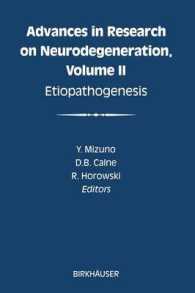Full Description
The Beacon Handbook and Desk Reference is a compact guide to a broad range of issues related to writing. Written in an accessible, non-technical style, The Beacon discusses the writing process, critical thinking, grammar, usage, punctuation, mechanics, and the research process, illustrating principles with both student and professional samples. The text's spiral binding makes it a convenient tool for students composing on the computer. Students receive the most up-to-date information on MLA documentation with the enclosed tri-fold card providing NEW 2009 MLA Handbook formats.
Contents
The Composing Process1. Planning1a A General Subject1b Ideas and Planning1c A Specific Topic1d Your Role, Readers, and Purpose1e A Working Thesis Statement2. Drafting2a Organizing Materials2b An Outline2c A Rough Draft2d A Title and Introductory and Concluding Paragraphs3. Revising3a Setting Aside the Rough Draft3b Content Revision3c Style Revision3d Technical Revision3e Peer Editing3f The Final Draft3g A Sample Paper4. Paragraphs4a Unified Paragraphs4b Coherent Paragraphs4c Paragraph Length4d Organization and Development5. Critical Thinking and Argumentation5a Principles of Reasoning5b Purpose of Writing5c Ways to Respond Critically5d Argumentation5e A Sample ArgumentESL Writers6. ESL Writers: Working beyond Mechanics6a Writing in the American Culture6b General Issues of Writing6c Special Concerns6d Technical Issues for ESL Writers: A GuideGrammatical Sentences7. Parts of Speech7a Nouns7b Pronouns7c Verbs7d Adjectives7e Adverbs7f Conjunctions7g Prepositions7h Interjections8. Sentences8a Parts of Sentences8b Kinds of Sentences9. Fragments9a Without Subjects or Verbs9b Subordinate Clauses9c Special Use of Fragments10. Comma Splices and Fused Sentences10a Forming Two Sentences10b Using a Semicolon10c Using Coordinating or Subordinating Conjunctions10d Conjunctive Adverbs11. Agreement11a Subjects and Verbs11b Pronouns and Antecedents12. Parallelism12a With Coordinating Conjunctions12b With Correlative Conjunctions12c Repetition of Sentence Elements13. Pronoun Reference13a Unclear Pronoun References13b Reflexive Pronouns and Subjects of Sentences13c Clear Pronoun References14. Pronoun Case14a Subjective Case14b Objective Case14c Possessive Case14d Appositives and Elliptical Constructions14e Who and Whoever and Whom and Whomever15. Positioning Modifiers15a Clarity and Smoothness15b Dangling Modifiers15c Squinting Modifiers16. Verb Tenses16a Verb Forms16b Simple Tenses16c Perfect Tenses16d Progressive Tenses16e Relationships Among Actions and Conditions16f Mood17. Adjectives and Adverbs17a Modifying Nouns and Pronouns17b Modifying Verbs, Adjectives, and Adverbs17c Positive, Comparative, and Superlative Adjective and Adverbs17d Troublesome Adjective and Adverb Pairs18. Sentence Variety18a Sentence Length18b Sentence Types18c Sentence Beginnings18d Coordination and Subordination19. Emphasis19a Active and Passive Sentences19b Concision20. Diction20a Levels of Diction20b Denotations and Connotations20c Specific Words20d Biased Language20e Slang and Regionalisms20f Cliches and Triteness20g Forms of Idioms20h Jargon20i Euphemisms20j Pretentious Language20k Figures of Speech20l Neologisms and ArchaismsPunctuation and Mechanics21. End Punctuation21a Periods21b Question Marks21c Exclamation Points22. Commas22a Three or More Items in a Series22b Compound and Compound-Complex Sentences22c Introductory Words and Phrases22d Nonrestrictive Information22e Contrasting Sentence Elements22f Expressions That Signal Direct Quotations22g Numbers, Dates, Addresses, Place Names, and Titles22h Unnecessary Commas23. Semicolons and Colons23a Independent Clauses23b Sentence Elements That Contain Commas23c Incorrect Use of Semicolons23d To Introduce Elements23e Numerals23f Incorrect Use of Colons24. Apostrophes24a Possessive Case24b Omission of Letters and Numbers24c Not with Possessive Pronouns25. Other Marks of Punctuation25a Dashes25b Hyphens25c Parentheses25d Brackets25e Ellipsis Points26. Capitals26a The First Word in Every Sentence26b Proper Nouns and Proper Adjectives26c Titles and Subtitles27. Italics27a Titles of Lengthy Published Works27b Specific Names of Ships, Trains, Aircraft, and Spacecraft27c Unfamiliar Foreign Words and Phrases27d Words Used as Words, Letters Used as Letters, and Numbers Used as Numbers27e For Emphasis28. Quotation Marks28a Direct Quotations and Dialogue28b Punctuation with Quotation Marks28c Titles of Brief Works, Parts of Long Works, and Unpublished Works28d Ironic or Other Special Use of a Word29. Numbers and Abbreviations29a Numbers29b Abbreviations30. Spelling30a General Rules30b Dictionaries30c Technical Words and British VariantsResearch31. Topic, Research, and Note Taking31a Subject to Topic31b A Working Thesis Statement or Research Question31c The Library31d Electronic Search Systems31e Online Periodical Databases31f Using Electronic Sources31g Selecting and Evaluating Sources31h Taking Notes31i Plagiarism32. Works-Cited Entries32a Citation Format32b Accuracy and Completeness32c Books32d Periodicals32e Nonprint Sources32f The Internet and Other Electronic Sources33. Organizing, Writing, and Documenting33a Organization33b A Rough Draft33c Incorporating Notes33d Parenthetical Notes33e Revision33f A Final Manuscript33g A Sample Research PaperDocument Design34. Document Design and Manuscript Preparation34a A Document''s Purpose34b Basic Printing Features34c Visual Elements34d Web Site DesignDesk ReferenceAppendixesA. APA Documentation StyleB. Writing Essay ExamsC. Business WritingD. Writing About LiteratureGlossary of UsageGlossary of Grammatical TermsGeneral Index








